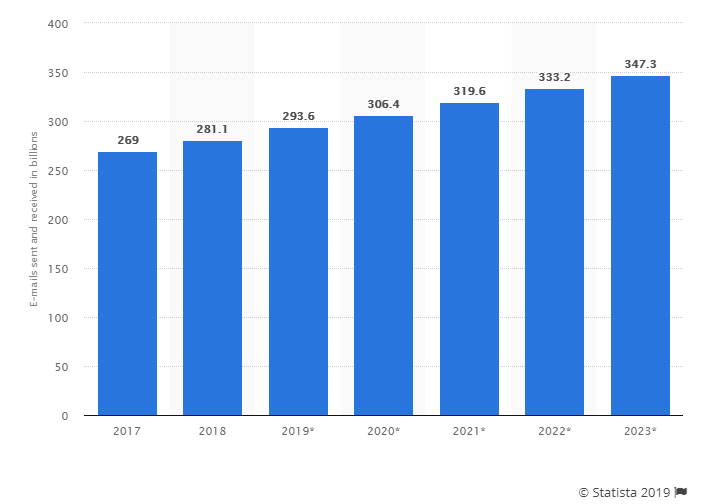
Cold email can be a massive driver of revenue growth… if you know what you’re doing.
The first hurdle most sales reps face is writing compelling cold email copy. It needs to be interesting, brief, provides value, and most importantly, get results.
In this guide, we’re going to show you the ingredients to a successful cold email.
We’re not going to show you a list of templates that are already used by thousands of sales reps around the world. Those won’t help you stand out in a crowded inbox.
We are going to show you the cold email copy best practices that will provide value to your prospects and increase your response rate.
Benefits of Writing Bulletproof Cold Email Copy
With over 293 million emails sent and received every day, your email marketing copy needs to stellar if you want to stand out.

If you’ve ever received cold emails from sales reps looking to win your business, then you know how high the bar is.
There are hundreds of blog posts with long lists of cold email templates out there. But, the truth is that everyone can tell when you’re sending a cold email based on a cookie-cutter template.
How can they tell?
Well, half of the sales teams in the world are using the same template! As soon as a site like Close or HubSpot publish their latest cold email templates, they’re going to be put to the test by sales reps.
They could be the best cold email templates ever seen, but if your prospect has already received an identical email from a different company previously that week, you’re not going to stand out.
So, what should you send?
The truth is, creating great cold email copy is hard.
You need to be unique, personal, friendly, brief, and provide huge value for your prospect.
Let’s take a look at the key ingredients to a cold email that’s going to get results.
How to Craft Your Cold Email
We’re going to take your cold email apart and examine it section-by-section. Then, you’ll be able to use this recipe to create killer cold email copy that gets one step closer to closing deals with ideal prospects.
Step 1: Subject Line
47% of recipients open emails based on subject line alone. Your prospects are no different.
If you don’t instantly catch their attention, it’s game over. Your email is going to sink to the bottom of their inbox and never get seen.
Therefore, your cold email subject line is key to a successful interaction.
You need to hook your prospect by providing value in a way that’s as personalized as possible.
Now, this doesn’t mean you can get by simply adding custom {{name}} or {{company}} fields within the subject line. Your recipients will see through that.
Ideally, you need to mention a unique pain point that they or their business has. Subject lines that feel unique (tailored to the recipient), or have a sense of urgency (agitate a pain point) have a 22% higher open rate than emails that don’t.
Additionally, if you met your prospect at a conference, or got their contact details through a mutual connection, you should reference that. A Nielson study found that 92% of people surveyed trust referrals from people they know. This gives your email an edge over the others in their inbox.
One final tip: keep your subject line short.
Over 41% of emails are opened on a mobile device, and if it’s too long your subject line will be cut off.
Cold email subject line examples:
- Noticed you’re using [competitor software]
- A tool to help raise your seed round
- Eliminating [customer pain point]
Section 2: Opening sentences
With the average email length being only 438 words, you need to get your point across quickly.
“Everyone’s inbox is overflowing. We’re all time-starved. So, we love succinct messages that help us make a quick decision: whether to reply or not, whether to click through or not.”—Henneke Duistermaat, founder of Enchanting Marketing
Your opening sentences need to catch their attention and show them why they should read on.
Firstly, why should they care about your email? Your opening sentence is an ideal place to show your recipient why they need to keep reading.
Sujan Patel, founder of Mailshake recommends skipping past any formalities. He writes “Don’t waste your opening line with “Hi, my name is so-and-so and I work at such-and-such company.” No one cares.”
Instead, agitate a pain point you know they have and show how you can cure it.
Example cold email opening sentences:
- “What would you do if you could reduce monthly churn by 5%?”
- “[Mutual connection] told me I should reach out to you about your email marketing.”
- “I noticed that your company just closed a new round of funding.”
Section 3: Body
Your opening lines hooked your prospect and they want to read on. Now you need to re-iterate the value you can provide them, and evoke a response or action.
Don’t try to sell too much, and keep your tone conversational but succinct.
Boomerang ran a study and found that the cold emails that got the most responses had 50 – 125 words total and were written to a 3rd-grade reading level.
Sleeknote conducted a similar test and found success with emails in the 75-100 word range.
You’re not trying to impress your prospect with your knowledge of language and grammar, but with your value proposition.
HubSpot even recommends trying out cold emails that contain two sentences or less. The brevity acknowledges you understand the prospect’s time is important and you respect their time.
Another cold email body copy best practice is to break up your copy with white space.
No one likes to open an email and see a wall of text!
One sentence paragraphs are completely acceptable and have been found to have a strong impact on readers.
Pro tip: Send your email to yourself, and open it on your smartphone before sending. Can you quickly scan it and extract the key value proposition?
Cold email body copy examples:
Example 1:
Noticed that you’re currently raising a new round of funding.
Our platform connects startups with investors looking for new opportunities in [ location].
Is that something you would be interested in?”.
Example 2:
“You’re currently using Product Y, but if you’re like most companies then you’re not using the full capabilities and could be wasting up to $1250 per month.
Our product has all of the same functionality for a fraction of the cost and we can migrate your data over within a few days.
Do you have 30 minutes free on Thursday to discuss?”
Example 3:
“Noticed on your careers page that you’re hiring 3 new sales associates.
Our platform connects rapidly growing companies like [Company] with experienced sales reps looking for new opportunities.
Is this something you’d be interested in trying out?“
Section 4: Call-To-Action
Your prospect finished reading your email and wants to learn more. You need to give them a clear next step.
Without a clear call-to-action, you’re not going to see the engagement you hope.
It needs to establish what they need to do.
Do you want them to reply with a simple ‘yes’? Pick a time to chat in your calendar? Or, do you want them to answer an open-ended question?
Here are three examples of a compelling cold email call-to-action.
- Do you have 30 minutes available on Tuesday to talk?
- If you’d like to learn more, click here to grab a time in my calendar to talk.
- Do you need help sourcing B2B contact data?
Key Rules to Keep In Mind
In this section, we’re going to reiterate a few critical rules that are often broken.
They are the cornerstone of any cold email campaign, and ignoring them could lead to campaigns with lackluster results.
1. Highly Targeted Campaigns Get the Best Results
You could have the best cold email copy ever seen, but, if you send it to the wrong prospects it’s not going to resonate.
Firstly you need to ensure your B2B buyer persona is up-to-date. This will ensure you’re targeting the correct decision-makers within your target companies.
Then, you need to source B2B contact data. You can use DemandScience to source verified B2B contact data for key decision-makers in companies around the world. You can create targeted prospect lists based on criteria such as job titles, industry, demographics, or technographics.
The more targeted your prospect list is, the more relevant your email will be to them.
2. Above All, Provide Value
This rule is related to your targeting criteria. If your targeting is spot-on, then your prospects will understand the value of your email.
By providing huge value to your prospects you make the email worth their time and improve your chances of a response. If you don’t provide them with any value or opportunity, you’re not going to see the results you’re hoping for.
If your prospect can’t refuse your offer, you can get away with weaker copy (however, we don’t recommend you test this!).
3. Do Your Research and Be Genuine
You need to be genuine. You’re talking to a real person.
If you don’t know your prospect, you also should refrain from personalizing too much. What do we mean by that?
Referring to publicly available information is fine. For example, saying congratulations that their company recently closed a new round of funding is a fair observation. It will be widely publicized, and if you don’t know that, you clearly haven’t done your research.
On the other hand, mentioning a comment they left on a LinkedIn post from two years ago may be over-personalizing. When you personalize too much, your email starts to sound less and less genuine.
4. Don’t Forget to Follow Up
Finally, remember to follow up with your prospects.
Woodpecker, a popular cold email software conducted a study on cold email sequence length.
They found that experienced sales reps who sent only one cold email received a 16% reply rate on average. By comparison, cold email campaigns with at least 1 follow-up had a reply rate of 27%.
This doesn’t mean you should be spamming your prospects with multiple emails per week. Be respectful of their time and attention.
We’d recommend staggering your follow-ups. Send one 2-3 days after your first email. Then, keep it to around 1 email per week, slowly increasing the length between emails.
If you respect your prospect’s time, they’re more likely to respond positively.
Recap
Cold email copy doesn’t have to rely on a stack of templates scraped from your favorite marketing blogs.
It can be compelling, provide value, and start conversations with your ideal customers.
Using these best practices your cold email campaigns will turn into a key driver of revenue for your company.










